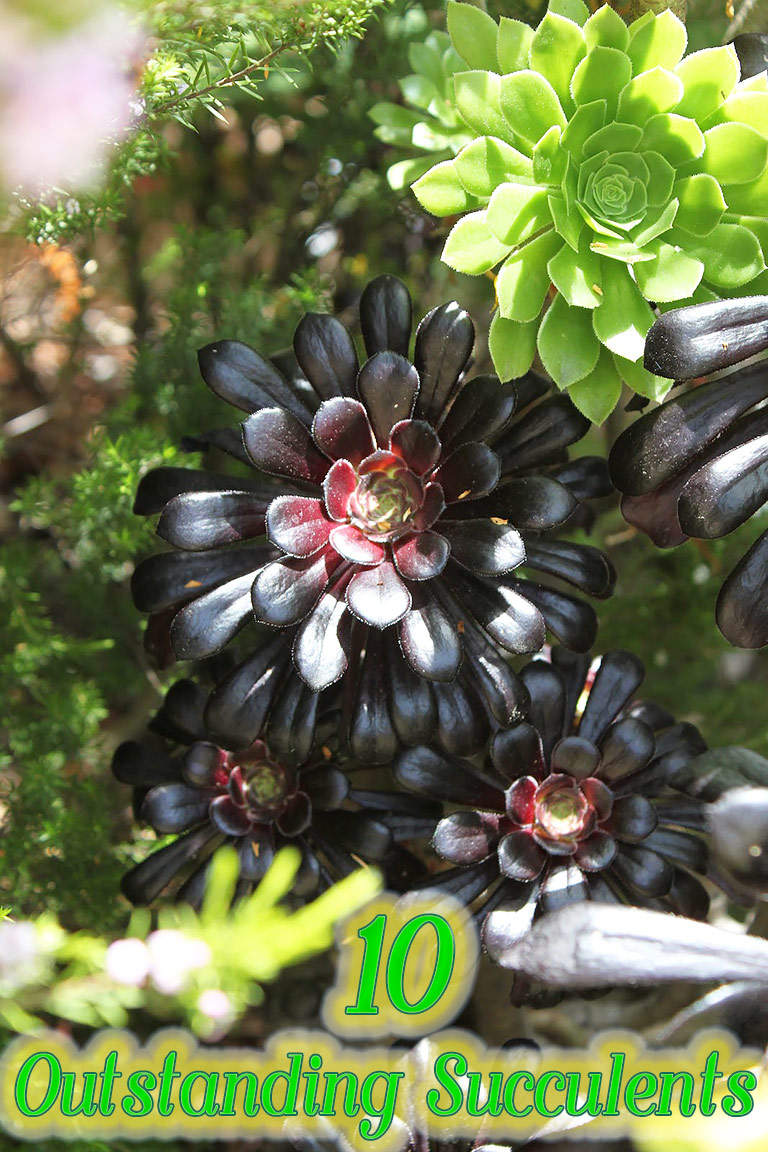
Succulents are the modern designer’s favorite freaks and geeks. They are a celebration of geometric form so rigid that the plants hardly seem to be living things. They can look like stones, can be toothed as an alligator, and occasionally morph into monstrosities that defy genetics. Every gardener should have at least one succulent plant. Despite plant tags and grower tips, however, some of these fleshy fellows remain notoriously fickle—prone to sudden meltdown, rot, and mummification.
Potted Succulents Need The Right Soil
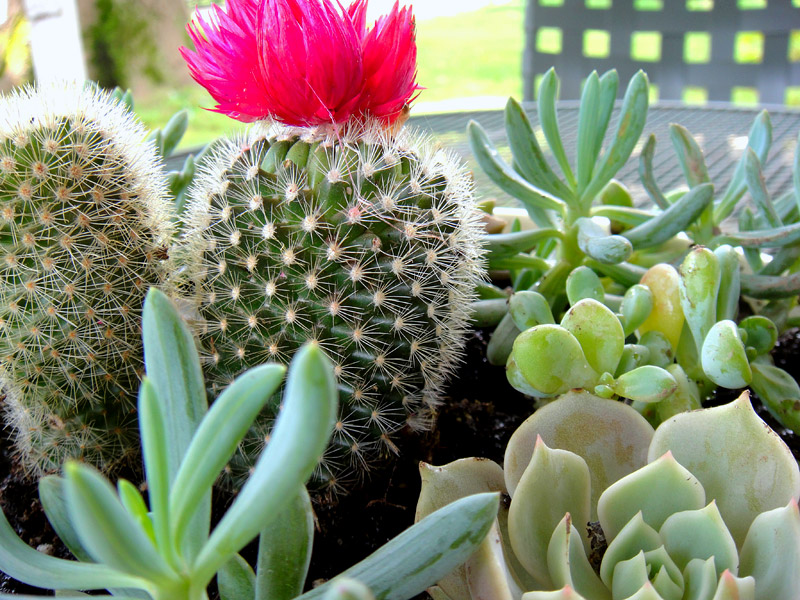
The biggest problem afflicting potted succulents is the use of soil mixes that are too rich in organic matter. Many bagged cactus soils, often labeled as suitable for cacti and palms, contain a lot of woody material, mostly because these soils are lighter and more inexpensive to ship than the coarse sand that succulents require. This organic matter then becomes a haven for infectious fungi. Succulents need lean, well-drained mineral soil, porous enough that water runs nearly straight through it.
An easy test to see if the cactus soil in question contains the right mix is to lift the bag: If it’s heavy, then you’ve found a good mix that includes sand; if it’s light, you’ll need to modify the soil. You can also modify regular potting mixes to suit your succulents. Follow some simple tips to provide the best soil for your succulents:
- Screen out woody particles from cactus mixes with a sheet of ¼-inch-grid hardware cloth to make it downright tough to overwater your succulents.
- Modify regular potting mixes by creating a 50/50 blend of potting mix and sharp sand.
- Fertilize regularly with low-dose fertilizer during the active seasons of spring and summer to compensate for a lack of fertility in the soil mix.
- Pair succulents with other succulents rather than with plants that require rich soil and even moisture. The two are typically not compatible.
With so many succulents out there, it’s impossible for home gardeners to tell the easy growers from the finicky specialties. The selections here offer a diverse mix of no-brainers to help you get started without risk of failure.
1. ADD COLOR TO A DREARY WINTER
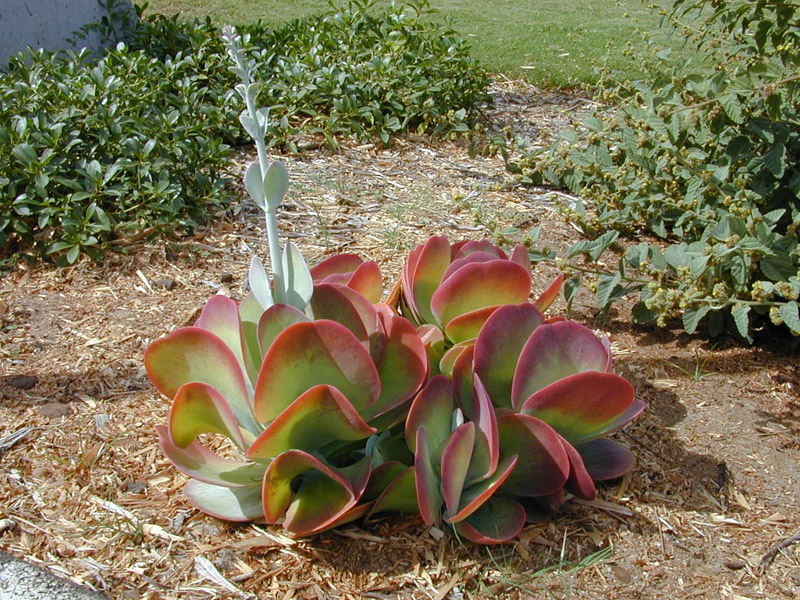
Name: Paddle plant (Kalanchoe thyrsiflora)
Zones: 10 to 11
Size: 1 foot tall and wide
Conditions: Bright shade
Paddle plant is the most popular modern succulent due to its whimsical form and intense winter color. Its leaves are flat, like pancakes, layered into an odd rosette. This plant bolts when it blooms, with the center stem elongating into a gangly white stalk. Those sold in nurseries are youngsters raised to maximum size for immediate use, but they do not last more than a year before bolting, which spoils their looks. Once paddle plant flowers, cut off the stem and give the remnant of the plant good care. It will soon produce many new offsets that can be plucked off and rooted.
2. THE SUCCULENT FOR ZINNIA LOVERS

Name: Tree aeonium (Aeonium arboreum and cvs.)
Zones: 9 to 11
Size: 6 to 24 inches tall and wide
Conditions: Full sun to light shade
If a zinnia were a succulent, it would be a tree aeonium. This species features two of the hottest varieties in the modern succulent world. Deep burgundy to black ‘Zwartkop’ is a powerful contrast against light green or yellow plants. ‘Sunburst’ has large cream-colored variegated leaves that can take on pink highlights. Over time, tree aeonium develops a thick trunk and may branch into sizable subshrubs that produce foot-long, cone-shaped stems of vivid yellow flowers.
3. DONKEY’S TAIL IS A UNIQUE SPILLER
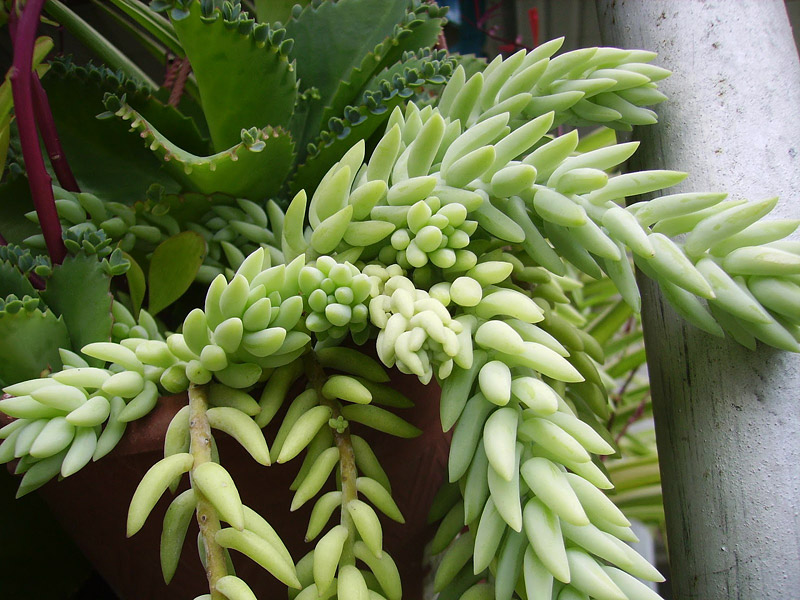
Name: Donkey’s tail (Sedum morganianum)
Zone: 11
Size: 2 feet long and 1 foot wide
Conditions: Bright shade
Show children a donkey’s tail and they will reach out to pinch the leaves of this unique vinelike succulent. It’s typically grown in a hanging basket where perfect drainage is assured. It also grows well dangling from a pot on a wall or balcony. This is not a heat lover, but it’s a cinch to grow in spots protected from wind. Give it a shaded location with filtered light for best results.
4. GET THE FLAMES WITHOUT THE FIRE
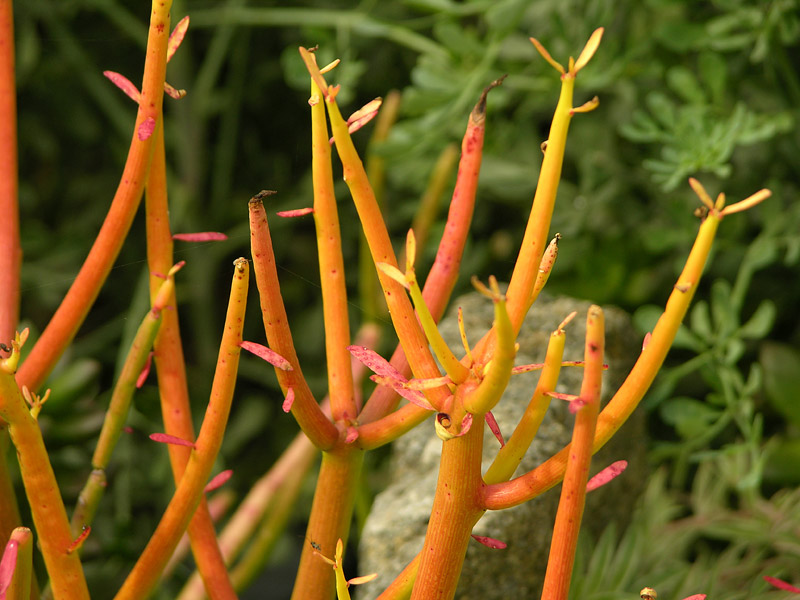
Name: Firesticks (Euphorbia tirucalli ‘Rosea’)
Zones: 9 to 11
Size: 3 feet tall and 2 feet wide
Conditions: Full sun
The pencil tree has been around forever, but Firesticks, the red form of the species, is a great design tool for its fine texture and vivid winter hues. The color is the result of reduced chlorophyll, which stunts growth and keeps this succulent small. The most intense color occurs in winter on plants in full sun. This species is more tolerant of ordinary soil than most succulents, so it’s often planted alongside moisture-loving plants.
5. A SINGLE SPECIMEN IS ALL YOU NEED
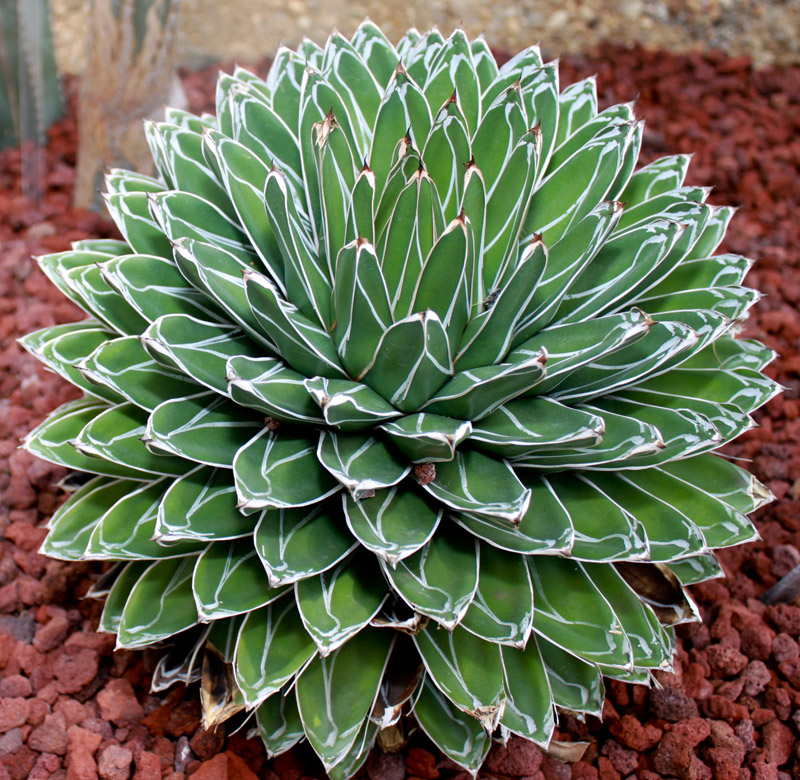
Name: Queen Victoria agave (Agave victoriae-reginae)
Zones: 9 to 11
Size: 1 foot tall and wide
Conditions: Full morning sun
A mature specimen of the small Queen Victoria agave can cost as much as a thousand dollars. But like all members of the Agave genus, it blooms just once at the end of its life (so you’ll most likely never see a bloom). Slow growth and exquisite beauty make this a prime single specimen. A mature plant is roughly the size of a volleyball and is rock hard, while the leaves are edged in white lines, which lend unique graphic quality to the plant.
6. PICK A COLOR, ANY COLOR
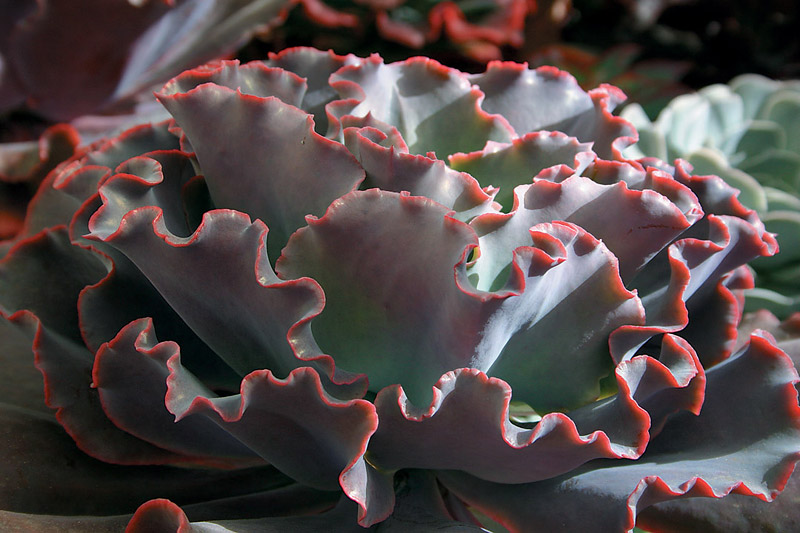
Name: Echeveria (Echeveria spp. and cvs.)
Zones: 9 to 11
Size: 1 to 2 inches tall and 3 to 4 inches wide
Conditions: Full sun to light shade
Echeveria is a collection of truly awesome succulents. The availability of dozens of different-colored hybrids makes them the paint-box plants to pair with glass gravel for outstanding potted specimens, though they look equally amazing in the landscape. Selecting by hand, rather than mail ordering, is the best method of getting the color you have in mind.
7. SMALL DOESN’T EQUAL WHIMPY
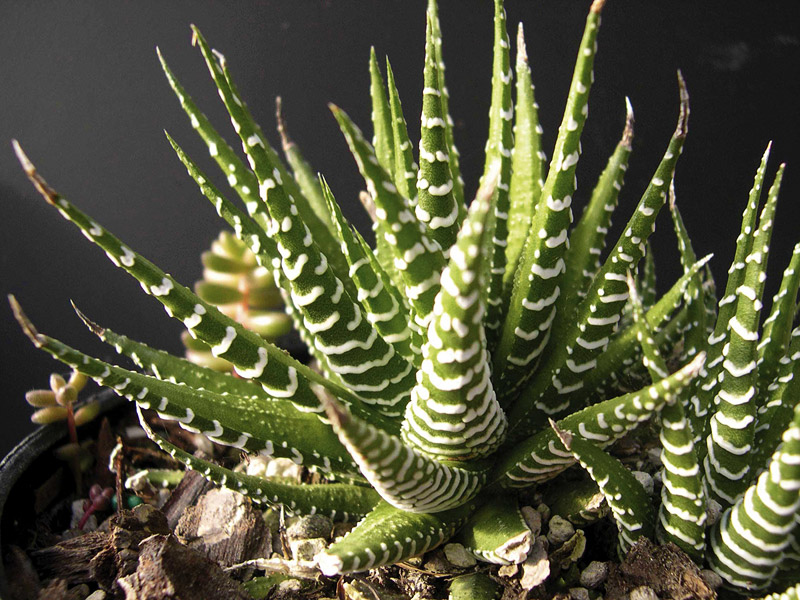
Name: Zebra haworthia (Haworthia attenuata)
Zone: 11
Size: 2 to 4 inches tall and 3 to 4 inches wide
Conditions: Full sun to filtered shade
Rub your finger along the leaves of this crocodile of a succulent to feel the unique hard warts that pock the surface. Though small, zebra haworthia’s hard, leathery surface makes it downright hard to kill—except with excess water or frost. This plant is a favorite for shallow bowls or bonsai pots, where it offsets freely, soon filling up the pot. It blooms on long piano-wire stalks with small, simple white flowers.
8. HUMMINGBIRDS LOVE THIS SPIDER
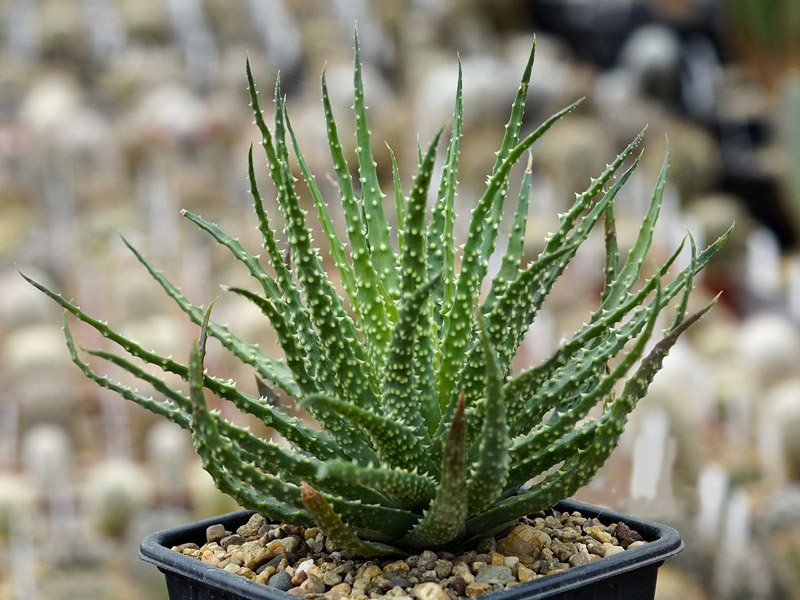
Name: Spider aloe (Aloe humilis)
Zones: 9 to 11
Size: 4 to 5 inches tall and wide
Conditions: Light shade
Fat and stubby, this cute little aloe blooms just as spectacularly as its larger African relatives. In spring, a foot-long spike emerges, topped with tubular, coral red blooms that hummingbirds find irresistible. This hand-size plant is ideal for low, wide bonsai pots. Its toothy leaves are thick and stiff, so its precise form is maintained at all times without flopping. Pairing several spider aloes with smooth river stones makes a beautiful little grouping.
9. THIS SUCCULENT BEARS THE COLD
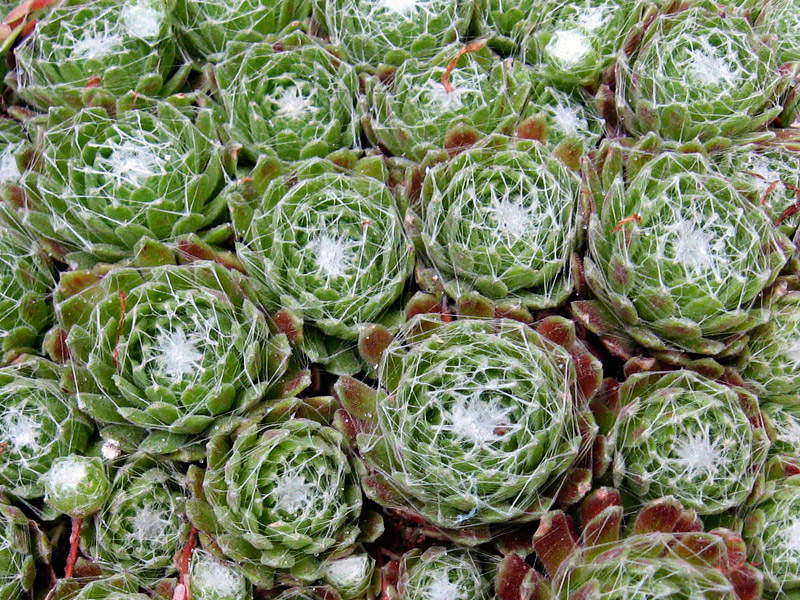
Name: Cobweb houseleek (Sempervivum arachnoideum)
Zones: 5 to 8
Size: 3 inches tall and 6 to 8 inches wide
Conditions: Full sun to partial shade
This cold-hardy succulent is one of the cutest small rosettes. It stands up to winter cold because it originates in the high mountains of Europe, where plants thrive in decomposing granite pockets on sun-drenched cliffs. Cobweb houseleek is named for the spiderlike appearance created when stems arch outward from between the leaves to bear offsets. These offsets are easy to sever and root into new plants. If you want to try this one, provide it with good drainage.
10. IF YOU LOVE BLUE, YOU’RE IN LUCK
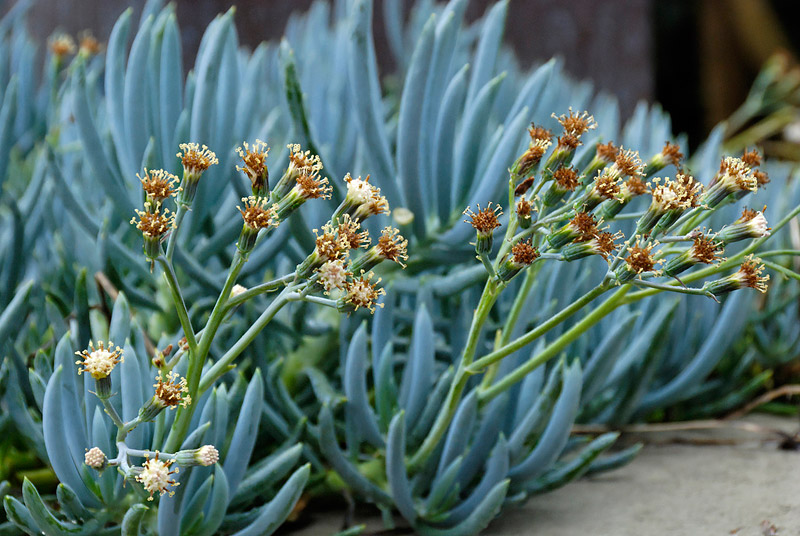
Name: Blue chalk sticks (Senecio mandraliscae)
Zones: 10 to 11
Size: 1 to 2 feet tall and wide
Conditions: Full sun
No succulent rivals this one for true blue coloring. It’s favored for mixed-succulent bowls, where it pops against yellow succulents. Blue chalk sticks can be shrubby or low spreading depending on the form you buy and whether you shape it. Leaves are pencil thin and upright, creating a spiky, fine-textured mass. This is an exceptional choice for unusual form in windowsill gardens.

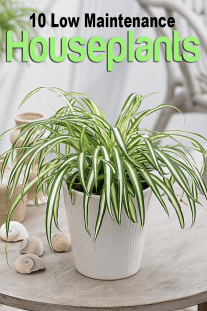
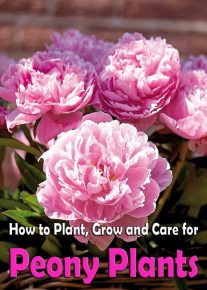
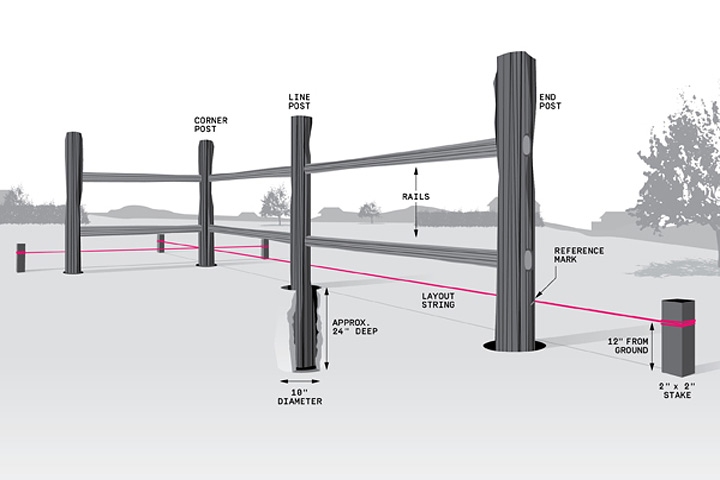
Leave a Reply